RTX RTX4006 UPCS Repeater User Manual Getting to know your Product
RTX Hong Kong Ltd. UPCS Repeater Getting to know your Product
RTX >
user manual
Contents
1) Getting to know your repeater......................2
Checking the package contents.............................2
How it works.........................................................2
Features............................................................3
Specifications...................................................4
2) Setting up your repeater................................4
Setting up the base................................................5
Changing the telephone system PIN................5
Automatic registration..........................................5
Manual registrationError! Bookmark not defined.
Registration for a daisy-chain layout ...................6
Registering to a different base..............................6
3) Installing the repeater....................................6
Finding the right location.....................................6
Map the base's coverage area...........................7
Test the location...............................................7
Installing the repeater...........................................8
Multiple-repeater systems.....................................8
Incorrect installation ........................................9
Correct installation...........................................9
Daisy-chain installations................................10
4) Troubleshooting and Maintenance.............11
Turning on the verification tone .........................11
Maintenance .......................................................12
5) Legal and warranty information ................12
Important safety instructions ..............................12
Important electrical considerations................13
FCC regulatory information...............................13
Part 15 compliance.........................................13
Privacy information .......................................14
Radio interference information......................14
I.C. Notice...........................................................15
Terminal Equipment ......................................15
Radio Equipment ...........................................15
One Year Limited Warranty................................15
Contact Information............................................17
Having Trouble? ............................................17
Need a Part?...................................................17
Help for our Special Needs Customers..........17
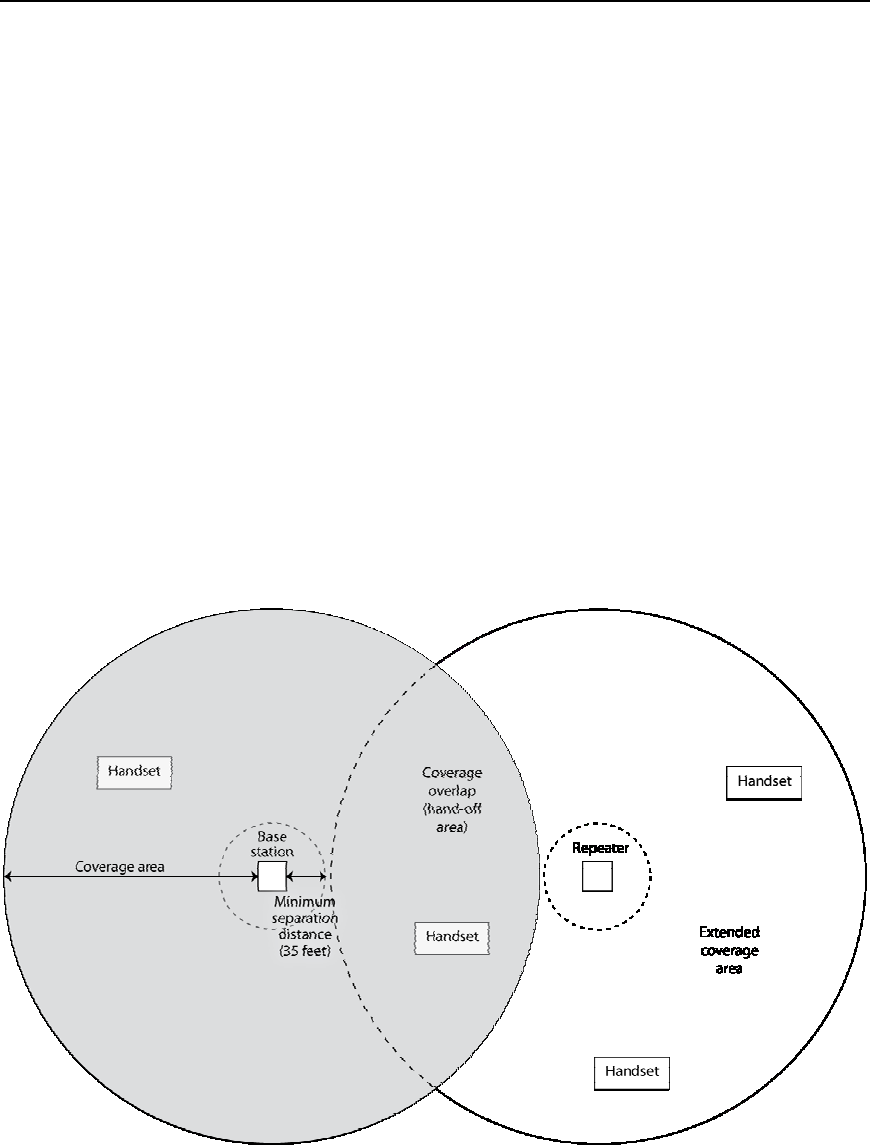
1) Getting to know your repeater
Checking the package contents
You should have received the following items:
• UDR100 DECT repeater
• AC adapter
• Mounting screw and wall anchor
How it works
The UDR100 repeater lets you extend the coverage area of your cordless DECT
telephone system in all directions, including up and down. If the repeaters are
installed so their coverage area overlaps the coverage area of the base, the base
can hand-off calls to the repeaters as the user moves from one coverage area to
another. When it's connected to the repeater, the mobile handset operates the
exact same way as it does when connected to the base, and the hand-off from
the base to the repeater can be completely invisible to the end user, even during
an active call.
Each base supports up to six repeaters, so you can extend coverage in all
directions, including through floors and ceilings:
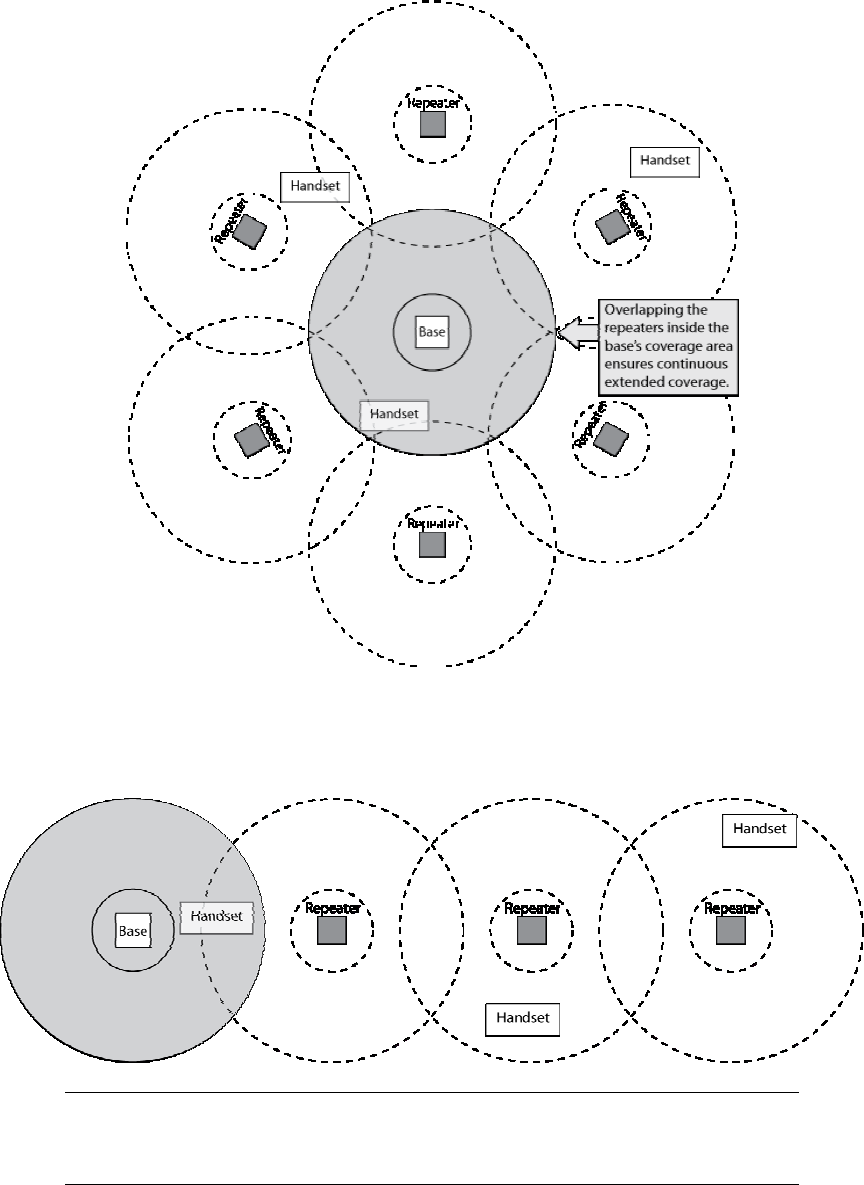
In addition, the UDR100 supports a sequential or "daisy chain" layout to extend
coverage in a single direction. Up to 3 repeaters can be installed in sequence:
For detailed information on daisy-chain layout and configuration,
contact your installer or refer to the UDR100 Administrator's Guide.
Features
• Automatic registration to the base
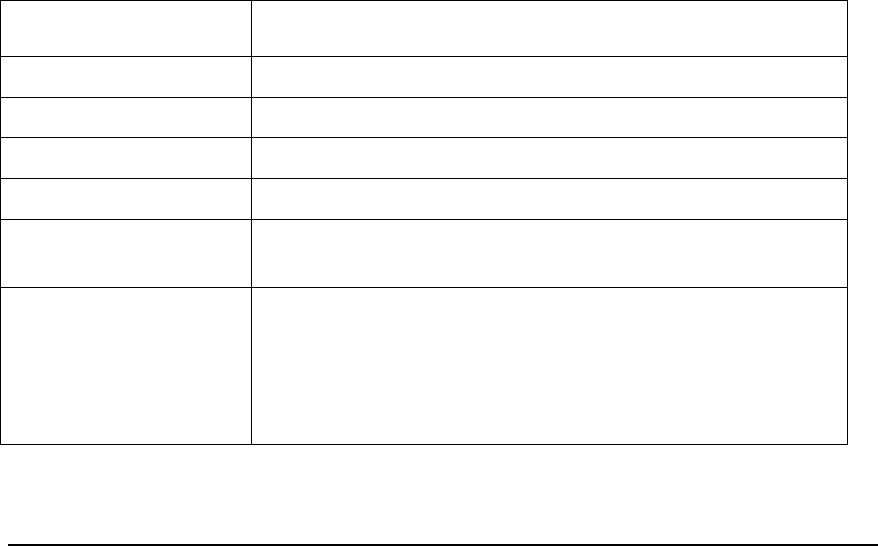
• Up to 6 repeaters per base station
• Up to 3 repeaters in a sequential or daisy-chain layout
• 2 internal antennas to support 2 simultaneous calls
• Repeater connection verification tone
• Low power consumption
Specifications
AC power adapter: Input: 100 -240VAC 50 -60Hz
Output; 5VDC 500mA
Unit weight: 5oz (142g)
Frequency band: 1920Mhz -1939Mhz
Transmit power: 110mW
Receiver sensitivity: <-92 dBm at 10-3 BER
Operating
Temperature 14° to 122° F (-10° to +50° C)
Standards:
Designed in accordance with the Digital Enhanced
Cordless Telecommunications (DECT) standard
Compliant with TBR6, TBR22 (Generic Access
Profile, GAP), and ETS 300 700 - ETSI Wireless
Relay Station Specification
2) Setting up your repeater
Before installing the repeater, you need to activate the repeater mode on your
base and then register the repeater to the base and any handsets. Before you
start the registration process, be sure you have
• A working base
• A working handset registered to that base
• Any repeaters you want to register to this base (you must complete the
registration process separately for each repeater)
• At least one of the AC adapters supplied with the repeaters.

Use ONLY the power adapter that came with your repeater. A
different power adapter may cause an electrical hazard or damage
the repeater.
Setting up the base
Changing the telephone system PIN
Before you start the registration process, you must reset the system PIN of your
telephone to 0000 (consult the manual that came with your base for more
information). After you reset the PIN, make sure to re-register the handset you
used back to the base station.
Automatic registration
The repeater seeks out the base with strongest DECT/GAP signal and
automatically registers to that base.
Step 1: Make sure the repeater is powered off (i.e., the AC power adapter is
not connected).
Step 2: Set the base into registration mode. (Consult the owner's manual that
came with your base station for more information.
Step 3: Use the AC adapter to connect the repeater to a standard 120 V AC
outlet. (Do not use a power outlet controlled by a wall switch.) The
LED on the repeater flashes briefly, then remains on and steady.
If the LED continues to flash, try registering the repeater again.
The repeater is now registered to this base and is ready to use.
You can safely disconnect the power and move the repeater to the selected
location; the repeater will stay registered to the base.
The repeater remains registered even if you disconnect the AC
adapter or there is a power failure. If you want to clear the
registration (for example, so you can register to a different base),
you must reset the repeater.

Registration for a daisy-chain layout
Registering the repeaters to operate in a daisy-chain or sequential layout
requires network administrator access and configuration software. Contact your
installer or refer to the UDR100 Administrator's Guide (provided with the
configuration software) for more information.
Registering to a different base
Once the repeater is registered, you need to reset it before you can change the
registration to a different base. If you want to reset the repeater and clear its
registration, follow the steps below:
Step 1: Disconnect the power.
Step 2: Reconnect the power for 1 to 5 seconds, and disconnect it again.
Step 3: Reconnect the power for 25 to 35 seconds.
Step 4: Disconnect the power, and perform the registration procedure with the
new base.
3) Installing the repeater
Finding the right location
To get the best operating conditions for the repeater, it is important to place it
correctly. Here are a few tips for placing repeaters.
• Place the repeater as high as possible, but at least 6 feet off the ground
• Make sure you have good reception from the base
• Make sure the location is close to a standard 120 V AC power outlet. Never
install electrical cords across a traffic area: they can create a trip hazard or
become damaged and create a fire or electrical hazard.
• Allow at least 30 feet between repeaters (if you are installing repeaters
across multiple floors, don't forget to allow 30 feet vertically, also)
• Avoid sources of electrical interference, such as hi-fi systems, office
equipment or microwave ovens.
• Avoid heat sources and direct sunlight
• Avoid things that can interfere with radio signals, such as metal doors, thick
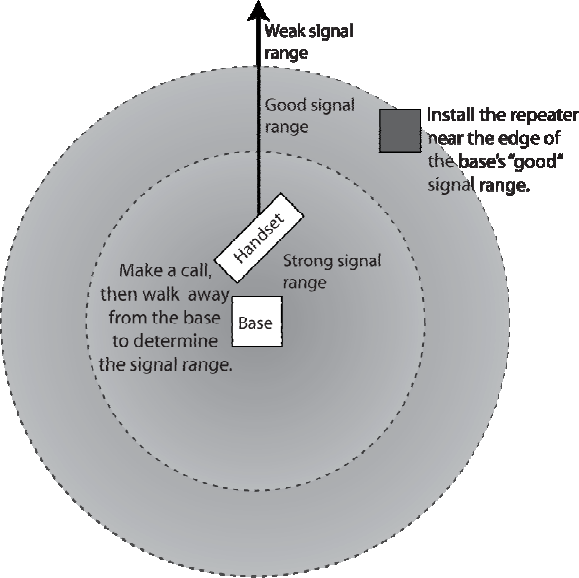
walls, niches and cupboards.
Map the base's coverage area
To find the best location for the repeater, you need to determine the base's
coverage area. Stand near the base and make a call. Walk away from the base
with the handset, and make a note where the signal becomes weaker. The
optimum location for the repeater is as far from the base as possible while still
maintaining a "good" signal, or just inside the location where the signal became
weaker.
Test the location
To test the location, plug the AC adapter into the repeater, then hold the repeater
in the place where you plan to mount it. The LED should remain on and steady,
indicating that the repeater has a good signal from the base.
If the LED flashes, the repeater is not getting a good signal. The repeater may be
too far away from the base, there may be interference from electronic devices, or
the signal might be blocked by thick walls or metal objects. Try moving the

repeater to another location.
Installing the repeater
Be sure the wall material can hold the weight of the repeater. Never
install a repeater in damaged or decaying wall material.
Step 1: Hold the repeater in its final location, and mark the center of the top
edge.
Step 2: From the edge mark, measure down approximately 1 1/2 inches, and
mark the screw location.
Step 3: At the screw location, use a 3/16ths drill bit to make a pilot hole
approximately 1 inch deep.
Step 4: Place the wall anchor into the pilot hole and tap it gently with a
hammer until the anchor is flush with the wall.
Step 5: Insert the mounting screw into the anchor, leaving approximately 1/4
inch space between the screw head and the wall.
Step 6: Put the repeater over the screw head and slide it down into place.
Step 7: Connect the repeater to the 120 V AC power outlet.
Multiple-repeater systems
You can register up to 6 repeaters to one base as long as the repeaters are a
minimum of 30 feet apart. Don't forget that the signal can cross through walls and
floors.
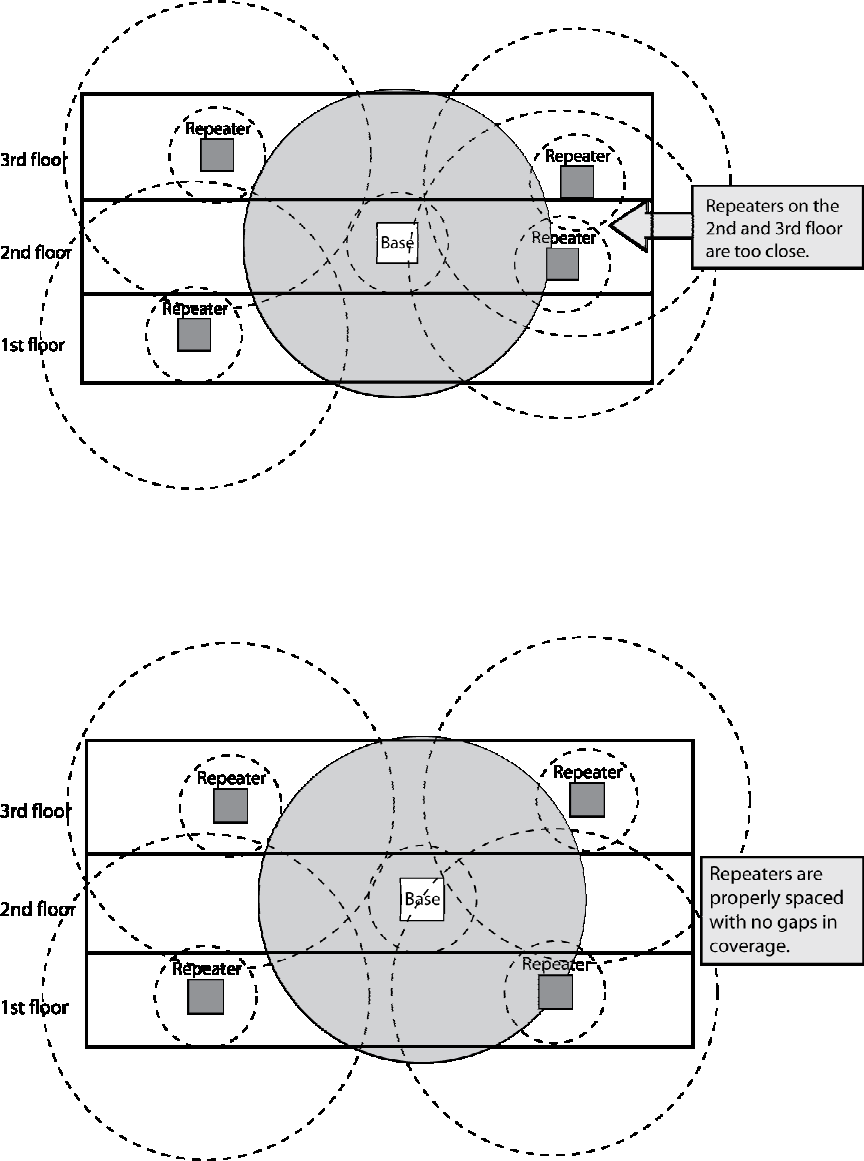
Incorrect installation
Correct installation
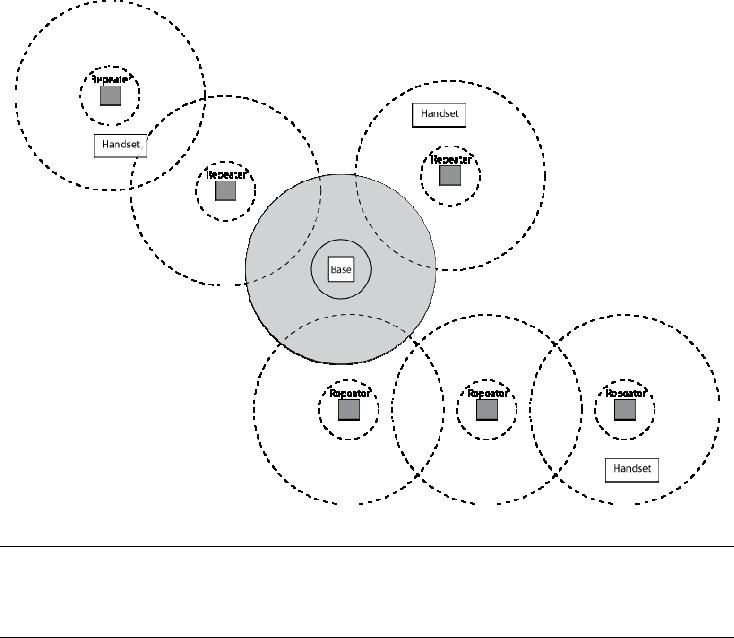
Daisy-chain installations
You can combine "normal" and "daisy-chain" connections to create a wide variety
of coverage configurations, as long as you have no more than six repeaters per
base unit:
For detailed information on daisy-chain layout and configuration,
contact your installer or refer to the UDR100 Administrator's Guide.

4) Troubleshooting and Maintenance
Problem Try...
There is a lot of static when
calls handoff to the repeater.
AND/OR
The LED on the repeater
won't stop flashing.
• Moving the repeater closer to the base.
• Checking for interference from electronic
devices.
• Making sure the repeater is not too close to
metal objects or thick walls.
Calls won't handoff to the
repeater.
• Making sure the repeater is inside the base's
good signal range.
• Making sure there is at least 35 feet between
repeaters.
• Resetting the repeater and registering it to
the base again (see Registering to a
different base)
I used to be able to connect
to the base, but now I can't.
• Making sure the repeater is powered on.
• Resetting the repeater and registering it to
the base again (see Registering to a
different base)
When I'm on a call, the
handset starts making a
strange tone. Turning off the verification tone (see below)
Turning on the verification tone
The verification tone is a useful tool for troubleshooting installation problems. If
you activate the verification tone, a handset sounds a continuous tone whenever
it moves into the extended coverage area of the repeater. The tone sounds as
long as the handset is connected to the repeater. This lets you use the
verification tone to map the coverage area of each repeater.
Step 1: Disconnect the power.
Step 2: Reconnect the power for 1 to 5 seconds, and disconnect it again.
Step 3: Reconnect the power and wait for the LED on front of the repeater to
start a slow flash.
Step 4: Disconnect the power, and immediately reconnect it. The verification
tone is then activated.
To turn the verification tone off again, repeat the procedure.

Maintenance
Caution: Unplug the repeater from the wall outlet before cleaning!
• Wipe the front of the repeater front with a damp cloth or an antistatic wipe.
• Do not apply liquid cleaners directly on the repeater.
• Never use aerosol cleaners or solvents.
• To avoid static discharge, never use a plain dry cloth.
5) Legal and warranty information
Important safety instructions
When using the telephone equipment, basic safety precautions should always be
followed to reduce the risk of fire, electrical shock, and injury to persons,
including the following:
• Read and understand all instructions.
• Follow all warnings and instructions marked on the product.
• Do not use this product near water; for example, near a sink or in a wet
area.
• Do not place this product on an unstable cart, stand, or table. The
telephone can fall, causing serious damage to the unit.
• To protect the product from overheating, do not block or cover any slots or
openings in the base unit. This product should never be placed near or over
a radiator or heat register. This product should not be placed in a built-in
installation unless the proper ventilation is provided.
• This product should be operated only from the type of power source
indicated on the marking label.
• Do not allow anything to rest on the power cord. Do not locate this product
where the cord will be damaged by people walking on it.
• Do not overload wall outlets and extension cords, as this can result in the
risk of fire or electrical shock.
• Never push objects of any kind into this product through the base unit slots,
as they may touch dangerous voltage points or short out parts that could
result in a risk of fire or electrical shock. Never spill liquid of any kind on the
product.

• To reduce the risk of electric shock, do not disassemble this product.
Contact qualified service personnel when some service or repair work is
required. Opening or removing covers may expose you to dangerous
voltages or other risks. Incorrect reassembly can cause electric shock when
the appliance is subsequently used.
Unplug this product from the wall outlet and refer servicing to qualified service
personnel under the following conditions:
• When the power supply cord is damaged or frayed.
• If liquid has been spilled onto the product.
• If the product has been exposed to water or rain.
• If the product does not operate normally when following the operating
instructions. Adjust only those controls that are covered by the operating
instructions. Improper adjustment of other controls can result in damage,
and will often require extensive work by a qualified technician to restore the
product to normal operation.
• If the product has been dropped, or the cabinet has been damaged.
• If the product exhibits a distinct change in performance.
Important electrical considerations
Do not attempt to unplug any appliance during an electrical storm.
Unplug all electrical appliances when you know an electrical storm is
approaching. Lightning can pass through your household wiring and damage any
device connected to it. This repeater is no exception.
Changes or modifications to this product not expressly approved by NEC
America, Inc., or operation of this product in any way other than as detailed by
this manual, could void your authority to operate this product.
FCC regulatory information
Part 15 compliance
This device complies with part 15 of the FCC rules. Operation is subject to the
following two conditions: (1) This device may not cause harmful interference, and
(2) This device must accept any interference received, including interference that
may cause undesired operation. Privacy of communications may not be ensured
when using this phone.
Privacy information
Cordless telephones are radio devices. Communications between the handset
and base of the cordless telephone are accomplished by means of radio waves
which are broadcast over the open airways. Because of the inherent physical
properties of radio waves, communication can be received by radio receiving
devices other than your own telephone unit, consequently, any communications
using the cordless telephone may not be private.
Radio interference information
Radio interference may occasionally cause buzzing and humming in your
cordless handset, or clicking noises in the base unit. This interference is caused
by external sources such as TV, fluorescent lighting, or electrical storm. Your unit
is NOT DEFECTIVE. If these noises continue and are too distracting, check
around your office to see what appliances may be causing the problem. In
addition, we recommend that the base not be plugged into a circuit that also
powers a major appliance because of the potential of interference. For best
performance, ensure that the antenna on the base unit is fully extended.
In the unlikely event that you consistently hear other voices or distracting
transmissions on your telephone, you may be receiving radio signals for another
cordless telephone or other source of interference. If you cannot eliminate this
type of interference, you need to change to a different channel.
Finally, it should be noted that some cordless telephones operate at frequencies
that may cause interference to nearby TVs and VCRs. To minimize or prevent
such interference, the base of the cordless telephone should not be placed near
or on top of a TV or VCR. If interference is experienced, moving the cordless
telephone farther away from the TV or VCR will often reduce or eliminate the
interference.
Radio interference causes interruptions in conversation. When this happens,
your unit is not defective. When noise continues, move to a different location
while you talk. (You might even need to move the base unit.) When the situation
persists, contact Uniden Customer Service.
Caution: To maintain compliance with the FCC’s RF exposure guidelines, place
the base unit at least 20cm from nearby persons.

I.C. Notice
Terminal Equipment
NOTICE: This equipment meets the applicable Industry Canada Terminal
Equipment Technical Specifications. This is confirmed by the registration number.
The abbreviation, IC, before the registration number signifies that registration
was performed based on a Declaration of Conformity indicating that Industry
Canada technical specifications were met. It does not imply that Industry Canada
approved the equipment.
Radio Equipment
The term “IC:” before the radio certification number only signifies that Industry
Canada technical specifications were met. Operation is subject to the following
two conditions: (1) this device may not cause interference, and (2) this device
must accept any interference, including interference that may cause undesired
operation of the device. “Privacy of communications may not be ensured when
using this telephone.”
One Year Limited Warranty
Important: Evidence of original purchase is required for warranty
service.
WARRANTOR: UNIDEN AMERICA CORPORATION (“Uniden”)
ELEMENTS OF WARRANTY: Uniden warrants, for one year, to the original retail
owner, this Uniden Product to be free from defects in materials and
craftsmanship with only the limitations or exclusions set out below.
WARRANTY DURATION: This warranty to the original user shall terminate and
be of no further effect 12 months after the date of original retail sale. The
warranty is invalid if the Product is
A. damaged or not maintained as reasonable or necessary,
B. modified, altered, or used as part of any conversion kits, subassemblies, or
any configurations not sold by Uniden,
C. improperly installed,
D. serviced or repaired by someone other than an authorized Uniden service
center for a defect or malfunction covered by this warranty,
E. used in any conjunction with equipment or parts or as part of any system
not manufactured by Uniden, or
F. installed or programmed by anyone other than as detailed by the owner’s
manual for this product.
STATEMENT OF REMEDY: In the event that the product does not conform to
this warranty at any time while this warranty is in effect, warrantor will either, at
its option, repair or replace the defective unit and return it to you without charge
for parts, service, or any other cost (except shipping and handling) incurred by
warrantor or its representatives in connection with the performance of this
warranty. Warrantor, at its option, may replace the unit with a new or refurbished
unit.
THE LIMITED WARRANTY SET FORTH ABOVE IS THE SOLE AND ENTIRE
WARRANTY PERTAINING TO THE PRODUCT AND IS IN LIEU OF AND
EXCLUDES ALL OTHER WARRANTIES OF ANY NATURE WHATSOEVER,
WHETHER EXPRESS, IMPLIED OR ARISING BY OPERATION OF LAW,
INCLUDING, BUT NOT LIMITED TO ANY IMPLIED WARRANTIES OF
MERCHANTABILITY OR FITNESS FOR A PARTICULAR PURPOSE. THIS
WARRANTY DOES NOT COVER OR PROVIDE FOR THE REIMBURSEMENT
OR PAYMENT OF INCIDENTAL OR CONSEQUENTIAL DAMAGES. Some
states do not allow this exclusion or limitation of incidental or consequential
damages so the above limitation or exclusion may not apply to you.
LEGAL REMEDIES: This warranty gives you specific legal rights, and you may
also have other rights which vary from state to state. This warranty is void
outside the United States of America and Canada.
PROCEDURE FOR OBTAINING PERFORMANCE OF WARRANTY: If, after
following the instructions in the owner’s manual you are certain that the Product
is defective, pack the Product carefully (preferably in its original packaging):
• Disconnect the battery from the Product and separately secure the battery
in its own separate packaging within the shipping carton.
• The Product should include all parts and accessories originally packaged
with the Product.
• Include evidence of original purchase and a note describing the defect that
has caused you to return it.
The Product should be shipped freight prepaid, by traceable means, to warrantor
at:
Uniden America Service
4700 Amon Carter Blvd.
Fort Worth, TX 76155
Contact Information
Having Trouble?
Our customer care specialists are here to help you! Visit our website at
www.uniden.com or call our Customer Hotline at 1-800-297-1023 during regular
business hours.*
Need a Part?
To order headsets, additional handsets, replacement batteries or other
accessories, visit our website at www.uniden.com or call 1-800-554-3988 during
regular business hours.*
Help for our Special Needs Customers
Uniden provides a customer service hotline for accessibility questions. If you
have disability and need customer service assistance or if you have any
questions about how Uniden’s products can accommodate persons with
disabilities, please call the accessibility voice/TTY line:
1-800-874-9314 (voice or TTY).
Accessibility information can be found on our website, www.uniden.com, under
the “Accessibility” link. If your call is received outside of our business hours,
leave us a message and we will call you back.
*Central Standard Time. Detailed customer service hours are available at
www.uniden.com.